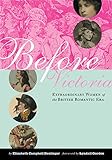Before Victoria : Extraordinary Women of the British Romantic Era / Elizabeth Denlinger.
Material type: TextPublisher: New York, NY : Columbia University Press, [2005]Copyright date: ©2005Description: 1 online resource (192 p.) : 50 color; 50 b&wContent type:
TextPublisher: New York, NY : Columbia University Press, [2005]Copyright date: ©2005Description: 1 online resource (192 p.) : 50 color; 50 b&wContent type: - 9780231136303
- 9780231509930
- Great Britain -- Biography
- Great Britain -- History -- 1789-1820 -- Biography
- Great Britain -- History -- 1800-1837 -- Biography
- Great Britain -- Social conditions -- 18th century
- Great Britain -- Social conditions -- 19th century
- Women -- Great Britain -- Biography
- HISTORY / Europe / Great Britain / General
- 305.4094109034
- online - DeGruyter
- Issued also in print.
| Item type | Current library | Call number | URL | Status | Notes | Barcode | |
|---|---|---|---|---|---|---|---|
 eBook
eBook
|
Biblioteca "Angelicum" Pont. Univ. S.Tommaso d'Aquino Nuvola online | online - DeGruyter (Browse shelf(Opens below)) | Online access | Not for loan (Accesso limitato) | Accesso per gli utenti autorizzati / Access for authorized users | (dgr)9780231509930 |
Frontmatter -- CONTENTS -- FOREWORD -- PREFACE -- 1. MARY ROBINSON, EIGHTEENTH-CENTURY ROMANTIC -- 2. EXEMPLARY WOMEN: MARY WOLLSTONECRAFT, HANNAH MORE, AND THEIR WORLDS -- 3. NOT QUITE GOOD ENOUGH: THREE IMPERFECT LIVES -- 4. THE MODERN VENUS, OR, IMPROPER LADIES AND OTHERS -- 5. STRONGER PASSIONS OF THE MIND: WOMEN IN LITERATURE AND THE VISUAL ARTS -- 6. RATIONAL DAMES AND LADIES ON HORSEBACK: SCIENTISTS AND TRAVELERS -- 7. THE YOUNGEST ROMANTICS -- THE PFORZHEIMER COLLECTION AND ITS FEMALE INHABITANTS: AN AFTERWORD -- NOTES -- SUGGESTED READING -- ACKNOWLEDGMENTS -- INDEX
restricted access online access with authorization star
http://purl.org/coar/access_right/c_16ec
It might not have the been the revolution that Mary Wollstonecraft called for in A Vindication of the Rights of Woman (1792), but the Romantic era did witness a dramatic change in women's lives. Combining literary and cultural history, this richly illustrated volume brings back to life a remarkable, though frequently overlooked, group of women who transformed British culture and inspired new ways of understanding feminine roles and female sexuality. What was this revolution like? Women were expected to be more moral, more constrained, and more private than in the eighteenth century, when women such as Georgiana Cavendish, Duchess of Devonshire crafted bold public personas. Genteel women no longer laughed aloud at bawdy jokes and noblewomen ran charity bazaars instead of private casinos. By 1800, motherhood had become a sacred calling and women who could afford to do so devoted themselves to the home. While this idealization of domesticity kept some women off the streets, it afforded others new opportunities. Often working from home, women wrote novels and poetry, sculpted busts, painted portraits, and conducted scientific research. They also seized the chance to do good, and crafted new public roles for themselves as philanthropists and reformers. Now-obscure female astronomers, photographers, sculptors, and mathematicians share these pages with celebrated writers such as Mary Shelley, her mother Mary Wollstonecraft, and Mary Robinson, who in addition to being a novelist and actress was also the mistress of the Prince of Wales. This book also makes full use of The New York Public Library's extensive collections, including graphic works and caricatures from the late eighteenth and early nineteenth centuries, manuscripts, hand-colored illustrations, broadsides, drawings, oil paintings, notebooks, albums and early photographs. These vivid, beautiful, and often humorous images depict these women, their works, and their social and domestic worlds.
Issued also in print.
Mode of access: Internet via World Wide Web.
In English.
Description based on online resource; title from PDF title page (publisher's Web site, viewed 02. Mrz 2022)


